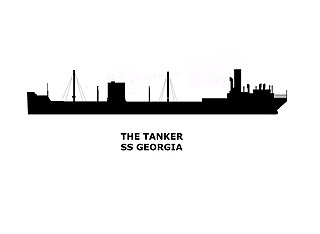HMT Cambridgeshire (FY142) was a British Second World War anti-submarine trawler of the British Royal Navy, named after Cambridgeshire, an English county.

The Arctic Corsair(H320) is a deep-sea trawler, built in 1960, that was converted to a museum ship in 1999. She is temporarily berthed at Alexandra Dock in Kingston upon Hull, England, pending completion of a new permanent location in the city's Museums Quarter. Exhibits and guides aboard the boat tell the story of Hull's deep-sea fishing industry.
HMT Warwick Deeping (H136) was a naval trawler of the British Royal Naval Patrol Service during World War II, sunk off the Isle of Wight in October 1940.

The Halcyon class was a class of 21 oil-fired minesweepers built for the British Royal Navy between 1933 and 1939. They were given traditional small ship names used historically by the Royal Navy and served during World War II.

SS Georgia was an oil tanker lost at Haisborough Sands off the coast of Norfolk, England in November 1927.
Brooke Marine was a Lowestoft-based shipbuilding firm. The company constructed boats and small ships for civilian and commercial use, as well as minor warships for the Royal Navy, Royal Navy of Oman, Royal Australian Navy, Kenya Navy and United States Navy.

Naval trawlers are vessels built along the lines of a fishing trawler but fitted out for naval purposes; they were widely used during the First and Second World Wars. Some—known in the Royal Navy as "Admiralty trawlers"— were purpose-built to naval specifications, others adapted from civilian use. Fishing trawlers were particularly suited for many naval requirements because they were robust vessels designed to work heavy trawls in all types of weather, and had large clear working decks. A minesweeper could be created by replacing the trawl with a mine sweep. Adding depth charge racks on the deck, ASDIC below, and a 3-inch (76 mm) or 4-inch (102 mm) gun in the bow equipped the trawler for anti-submarine duties.
HM Trawler Arab was a trawler launched in 1936. At the outbreak of World War II, she became a naval trawler serving in the Royal Naval Patrol Service. Lieutenant Richard Been Stannard won the Victoria Cross (VC) while serving as her commander during the Namsos campaign in 1940. The Admiralty returned her to her owners in 1945 and she remained in commercial service until she was scrapped at Ghent in 1963.

SS Monte Nevoso was a cargo steamship that was launched in 1920 in England, owned in Italy, and wrecked in 1932 in the North Sea off the coast of Norfolk.

SS Meriones was a Blue Funnel Line refrigerated cargo steamship. She was launched in 1921 on the River Tyne as one of a class of 11 ships to replace many of Blue Funnel's losses in the First World War.
SS Gallois was one of seven merchant vessels which became stranded and then wrecked on Haisbro Sands of the Norfolk coast on 6 August 1941 during the Second World War. The SS Gallois had been part of a convoy with the designation Convoy FS 559.

HMS Sir Galahad was a trawler built for the British Royal Navy in 1941. Post war it was sold into civilian service and was wrecked in 1957 after running aground off the Isle of Mull.

HM Trawler Agate was purchased by the Royal Navy in 1935. She was modified from a trawler to be used to carry out anti-submarine work. In 1941 she was with the maintenance reserve at Rosyth, but in August was part of the Royal Navy's escort flotilla with convoy FS559 when she ran aground, becoming a total loss, on Haisborough Sands on 6 August with a loss of sixteen crewmen.
HMT Laurel was a trawler launched in 1930 that the Admiralty acquired in 1935 and converted to a minesweeper. She served throughout World War II before being sold in 1946. After many years commercial service she was scrapped in 1955.
SS Empire Tower was a British 4,378 GRT cargo ship built in 1935 and sunk by enemy action in 1943.

HM Trawler Alvis was a British trawler that was taken up from trade and used by the Royal Navy during the Second World War. She was returned to the fishing industry at the end of hostilities in 1945.
Preußen was a fishing trawler requisitioned during World War II by the Kriegsmarine for use as a Vorpostenboot. She was built in 1930 as August Wriedt, and was renamed Preußen in 1933. On 13 August 1944, she was sunk off Langeoog by Bristol Beaufighter aircraft of 254 Squadron, Royal Air Force.
Caldew was a British steam fishing trawler. Launched in 1914 as Maristo, she was requisitioned by the Royal Navy for service in the First World War the following year. Maristo survived the war and resumed trawling for the next two decades, being renamed Caldew in that time. She collided with fellow trawler Ospray II in 1935, sinking the latter ship.
Junella was a fishing trawler, best known for her service with the Royal Navy during the Falklands War. She was built in 1975 for J Marr & Son, a Hull-based fishing company. On 11 April 1982 she was taken up from trade by the British government and commissioned into the Royal Navy. She was fitted with Second World War era minesweeping gear at Rosyth Dockyard, manned by Royal Navy sailors and allocated to the 11th Mine Countermeasures Squadron. She sailed on 26 April but was unable to commence sweeping until after the 14 June Argentine surrender. In the meantime she was utilised to transfer troops and stores between ships and landed special forces troops at San Carlos. Demining operations commenced on 21 June. Junella returned to the United Kingdom on 11 August, carrying a defused Argentine mine.










